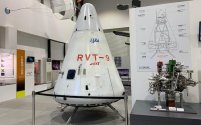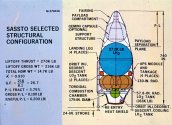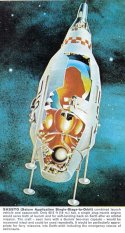The fact that they have ended up with architectures for CZ-10 and CZ-9 which are reminiscent of Falcon 9/Heavy and Super Heavy respectively, is not a glowing endorsement of their prior design thinking and ambition. If anything it is an endorsement of SpaceX.
China has always acknowledged the viability of reusable rocket technology. SpaceX was the first to apply VTVL (Vertical Take-off, Vertical Landing) to an orbital launch vehicle. Prior to that, VTVL was primarily used for lunar landers, such as in America’s Apollo program and China’s Chang’e lunar missions.
China is researching nearly all types of reusable launch vehicle technologies, each with its own objective. This ranges from the parachute recovery system of the Kistler K1, to reusable re-entry spaceplanes like the X-37B, to the BS-1 rocketplane (which, in fact, was the direction favored by the international space community before 2010: a VTHL model powered by an RBCC engine), and future two-stage horizontal take-off launch vehicles (an HTHL model using TBCC propulsion).
VTVL was an unexpected approach for the global aerospace community; no one anticipated it would become practical. SpaceX and Blue Origin are the true pioneers of this current wave of VTVL development.
In my opinion, the Falcon 9 initially followed the K1 recovery path (a point confirmed in Chinese aerospace research literature). It was likely the competitive pressure from Blue Origin’s suborbital human spaceflight program that pushed SpaceX to fully commit to the VTVL route.
The requirements for the CZ-10 in the early studies were different from what came later.
Initially, China's moon landing plan involved three launches: two CZ-5DY rockets (with a 20t LTO capacity) plus one CZ-5 crewed version (with an 8-10t LTO capacity). The CZ-5DY was essentially a kerosene-fueled first-stage version of the CZ-5 (with an LEO capacity >40t), whereas the CZ-5 used a hydrogen-oxygen (hydrolox) first stage. Because the CZ-5DY's capacity was too large and China wanted to preserve its hydrolox propulsion technology, the CZ-5DY was not pursued at the time.
The early requirement for China's crewed lunar spacecraft was around 20 tons; it was only in recent years that this was increased to 27 tons. The essence of the mission, however, has not changed. If you understand the Saturn V mission, it was for a 50t LTO payload requirement (this is how it's thought of within China's aerospace community). The early moon landing plan essentially broke this 50t LTO requirement into three separate launches.
The latest CZ-10 plan, however, breaks it down into two launches. The adjustment to the CZ-10 plan was actually about reducing launch difficulty, primarily because of the extremely high boil-off rate of liquid hydrogen. The early launch plan was essentially to burn all the propellant as quickly as possible after launch (including the liquid hydrogen in the upper stage) to avoid the problem of fuel boil-off during LEO docking (the Ares V had this same problem, which was a major headache). This is why China's crewed moon landing plan required the crewed version of the Long March 5 (as stated in Long Lehao's 2010 paper). The CZ-2F can only perform docking in low Earth orbit, which would cause the entire mission to encounter the same problem that New Glenn and Starship face today (the boil-off of cryogenic propellants during long-duration storage in orbit).
This was especially true after the CZ-5 ran into problems (its initial design flaws were discovered around 2011, requiring extensive reinforcements). In 2013, the previous plan for a three-launch moon landing in 2024 was halted. This led to a new selection process in 2018, where it was decided that a three-launch plan was still too troublesome, and it was switched to a two-launch plan with direct docking in lunar orbit. This required a rocket with greater thrust and a better orbital insertion scheme. The old CZ-5DY, with its maximum of 16 engines, was not enough, and more would need to be added. This led to two proposals: a 3x7 configuration (21 engines) and a 5x4 configuration (20 engines), corresponding to the 3-CBC and 5-CBC technical approaches.
The actual re-selection involved three competing proposals: the CZ-9B, the current 3-CBC CZ-10, and the predecessor of the 5-CBC CZ-12. The 3-CBC CZ-10 was chosen because it had greater potential for reusability—at least it would only require recovering three boosters simultaneously instead of five (the CZ-9 was chosen for the same reason). In reality, none of the competing models at the time had recovery capabilities because the engines and the airframe were mismatched (the YF-100's thrust was too large). This mismatch is also a primary reason why the CZ-10 adopted a cable-driven tether recovery system.
So, for you to say that the CZ-10 was created to copy the Heavy Falcon out of admiration for it is truly speechless for me. China's CZ-10 initially did not consider recovery; recovery was actually a later-added feature. It required solving the problem of a 1/5 throttling engine, something you have no idea about. Getting a 100-ton-class engine, especially one using a staged-combustion cycle, to achieve this level of throttling is incredibly troublesome. As of 2024, it has only been solved to the extent of 1/3 throttling, which is barely usable. Back in 2018, as a national project, reusability was not considered in the initial stages, so when the CZ-10 was initiated, there was no such requirement at all.
This is just like the CZ-9B. Many people think that because it has an engine in the middle, it can perform a vertical landing. The problem is that the first stage of the CZ-9B has a dry mass of around 100 tons, but it's paired with the YF-130 engine, which has a thrust of 500 tons. It would be fortunate if its minimum thrust could be reduced to 250 tons. How could it possibly be reused? The other 5-CBC proposal had the same problem.
So, the truth is, the choice of the CZ-10 had little to do with the Heavy Falcon. It was only later recognized that it simply had the potential for recovery.



